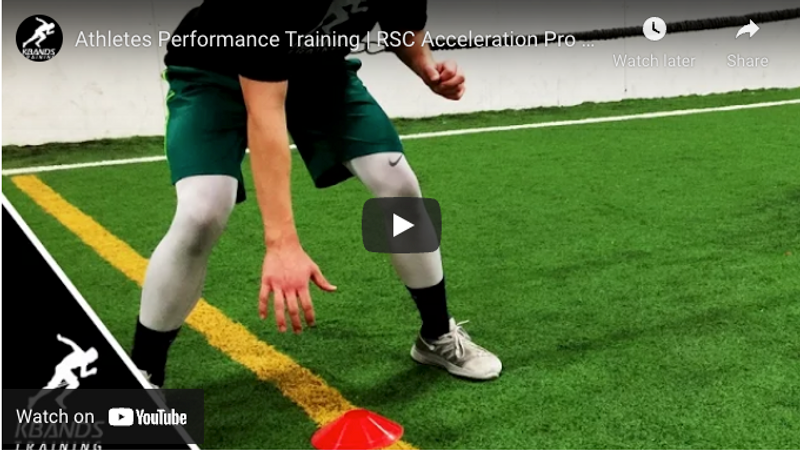Athletes Performance Training For Speed
Many sports such as football, basketball, baseball, and soccer all require athletes to make quick and sudden changes in direction. An athletes’ ability to use good footwork and body positioning will help minimize the amount of time it takes an athlete to change directions. This quick and decisive redirection can be the difference between making a tackle or maneuvering around a defender.
Athletes can also use different types of resistance to enhance their performance training. Using the Kbands Leg Resistance Bands, Reactive Stretch Cord, or Victory Ropes will force athletes to work harder and improve on their stride length and stride frequency. Speed and Agility Drills like the Assisted 40 Yard Dash, Wall Runs, or Pro Agility Test are great performance training drills to pair with resistance equipment to help improve athletic performance.
RSC Acceleration Pro Agility Test
The RSC Acceleration Pro Agility Test is performed in the same manner as the traditional pro agility test. Athletes will need three Speed and Agility Cones. Place the three Speed and Agility Cones in a straight line with five yards between each Speed and Agility Cone. The additional benefits the RSC Acceleration Pro Agility Test offer come from the use of the Reactive Stretch Cord during the performance training drill. Athletes will place the Reactive Stretch Cords Adjustable Belt around their waist and move to the center Speed and Agility Cone. A coach or assisting partner will grasp the Anchor Strap around their wrist and stand just to the side of one end of the Speed and Agility Cone set up. Partners will want to start the RSC Acceleration Pro Agility Test with some tension on the Reactive Stretch Cord to create an assisted feeling as the athlete performs the RSC Acceleration Pro Agility Test.
To begin the drill athletes will move into a good athletic performance position and sprint toward the Speed and Agility Cone closest to their partner. Upon reaching the Speed and Agility Cone athletes will turn and run to the opposite end of the Speed and Agility Cone set up. Partners will move with the athlete, being sure to maintain proper tension on the Reactive Stretch Cord throughout the RSC Acceleration Pro Agility Test. After athletes have reached the Speed and Agility Cone they will turn and sprint toward their partner, through the end of the Speed and Agility Cone set up. As athletes make their final sprint partners will need to turn and sprint with the athlete to maintain proper assistance for the final sprinting portion of the RSC Acceleration Pro Agility Test. Also ensure the RSC does become a tripping hazard for the athlete as they sprint toward the partner.
Athletes will perform 8-10 resisted sets of the RSC Acceleration Pro Agility Test before removing the Reactive Stretch Cord and performing 4-6 unresisted sets of the performance training drill. Athletes who wish to continually challenge themselves can add more resistance by adding Kbands Leg Resistance Bands to the Pro Agility Test. Kbands will give additional performance training to the muscles of the hip flexors and upper thighs. These should also be removed during the unresisted portion of the training workout.
Monitor Athletes Performance During Pro Agility Test
Coaches and athletes performance training should always be tracked and monitored so improvements can be monitored and measured. When athletes’ performance training becomes too easy, or measurable results are no longer improving, small changes in athletes performance training should be made. Adaptations to performance training that can be made are increasing the number of repetitions, increasing or decreasing rest periods between sets, or adding additional resistance to performance training.
To monitor and track an athletes’ performance during the RSC Acceleration Pro Agility Test athletes will need an additional coach or partner to be close by with a stop watch. Partners timing the Pro Agility Test will start the time on a verbal cue (given by the timer), when the athletes hand touches the top of the center Speed and Agility Cone, or on the first movement of the athlete. Partners will stop the time for the RSC Acceleration Pro Agility Test when the athlete passes the final Speed and Agility Cone and sprints past the Acceleration Pro Agility Test three cone set up. After each repetition of the RSC Acceleration Pro Agility Test athlete and partners should look at the time of the performance training, and discuss possible form and technique adjustments that can help the athlete improve their time. Unresisted sets of the Pro Agility Test are when athletes and partners should take notice of the times of the performance training. Athletes who wish to play competitively at the next level will need to find ways to knock tenths of a second of their Pro Agility Test time in order to stand out from other athletes.
Advanced Performance Training
The athletes who should use performance training drills like the RSC Acceleration Pro Agility Test are athletes who are preparing for a combine style workout (for a school or club team) in which their speed and quickness must be highlighted in order to make a positive impression. Athletes should also perform advanced athletic performance training for the overall goal of gaining more speed, agility, and overall athleticism.
Athletes can explore the Speed 101 Program for a complete performance training speed workout. Speed 101 Training will give athletes’ additional speed and performance training drill that will help athletes showcase their speed and athleticism. Athletes should also use workouts like the Dynamic Strength XP and Shoulder Progression to build additional strength in the upper body, lower body, and core. This additional strength will make for faster and more powerful running and sprinting movements. Athletes can always start or finish their workouts with the Rejuvenating Stretching Sequence, as well as additional flexibility stretching. The Rejuvenating Stretching Sequence Incorporates the Recovery Foam Roller and aids the body in the overall recovery process and muscle soreness before and after performance training sessions.

